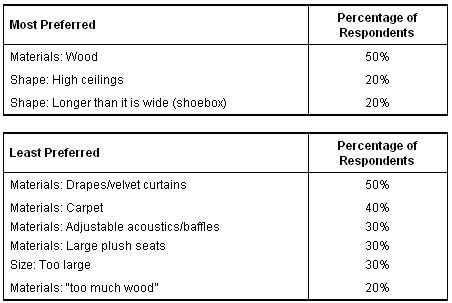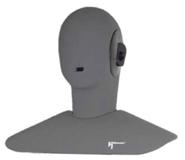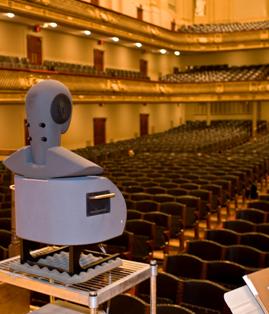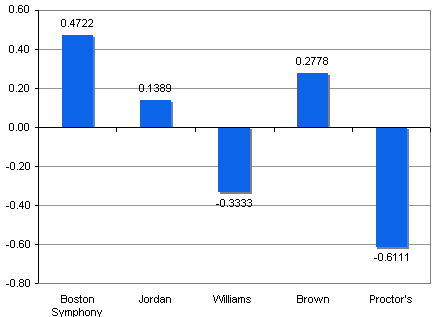Acoustical Society of America
157th Meeting Lay Language Papers
Singers' Preferences for Acoustical Characteristics of Performing Spaces
Kathleen Stetson - kathleen.stetson@arup.com
Arup Acoustics
New York, NY
Jonas Braasch - braasj@rpi.edu
Rensselaer Polytechnic Institute
Troy, NY
Popular version of paper 2pAA8
Presented Tuesday afternoon, May 19, 2009
157th ASA Meeting, Portland, OR
Classical singers are unique among musicians due to their instruments close proximity to their ears. A singers voice is conducted to his ears not only through the air surrounding him, but through the bone and tissue of his body. This relationship produces a sound level at the ear that is one of the highest of all musicians, and thus singers require particular attention from acousticians addressing the auditory needs of musicians in performance space design.
To inform room design and lead to more specific future research, this study explored the basic likes and dislikes of unamplified solo singers in two ways. First, the numerical and narrative responses to a survey given to a number of professional singers with experience in standard opera and art song repertoire were analyzed. Second, the results of psychoacoustic preference tests, which enabled singers to vocalize in and aurally experience five real concert halls through real-time auralization, were correlated with the objective parameters and physical elements of each hall.
Survey
In a similar approach to previous studies on instrumentalists and conductors acoustic preferences, a survey was conducted among experienced professional singers. Ten respondents, ages 21-70, seven of whom have sung in more than 50 concert halls or opera houses, answered numerical and narrative questions.
It was found that a singers acoustical environment does affect his ability to perform well. While a singer will perform in poor acoustical situations, a good acoustical environment allows the singer to sing with confidence and ease. The graph below displays the auditory phenomena singers listed when asked what they would like to experience while singing. Singers responded overwhelmingly that they require reverberation to be able to hear themselves in a performing space. Additionally, singers ability to hear themselves and their accompaniment in balance is essential to a successful performance.
| Figure 1. Survey respondents preferences for auditory phenomena during performance. |
While singers were not asked directly what physical aspects of performing spaces produced the above preferred auditory phenomena, respondents offered partiality for shape, materiality, and size throughout their responses. As seen in the table below, half of the singers offered a preference for performing spaces featuring wood and a dislike of those with absorptive elements like drapery.
 |
| Figure 2. Survey respondents preferences for physical characteristics of performing spaces. Only characteristics mentioned by 20% or more of respondents are shown. |
Preference Experiment
In an attempt to directly correlate objective parameters (such as reverberation time and clarity) and physical hall characteristics with singers preferences, professional singers participated in a preference experiment allowing them to sing in five different performing spaces and rate their preferences for each. Real-time auralization enabled singers to experience these situations back-to-back, enabling direct comparison.
The impulse responses used in the preference test were measured in the five unoccupied halls seen below from the singers perspective on stage. The close proximity of a singers mouth and ears was captured with a head and torso simulator with microphones in its ears and a speaker in its mouth.
 |
 |
| Figure 3. Head Acoustics head and torso simulator used to measure impulse responses from the singers perspective. |
Figure 4. Boston Symphony Hall, Boston, MA |
| Figure 5. Brown Hall, New England Conservatory of Music, Boston, MA | Figure 6.Williams Hall, New England Conservatory of Music, Boston, MA |
| Figure 7. Jordan Hall, New England Conservatory of Music, Boston, MA | Figure 8. Proctors Theatre, Schenectady, NY |
Nine participants, singing classical excerpts of their choice, compared each of the five halls to each other at two different positions on stage: downstage center, and at the back or side of the stage. The average preference ratings for each hall can be seen in the graphs below.
 |
 |
| Figure 9. Average preference rating when the singer is downstage at center.* | Figure 10. Average preference rating when the singer is positioned at the side or back of the stage.* |
*Note: Proctor’s Theatre was measured without the orchestra shell normally used for classical concerts and recitals.
The tests revealed a highly statistically significant result: regardless of the singing location on stage or the classical genre being sung, test subjects indicated a dislike of or preference for each hall. This suggests that while some halls may be preferred for certain types of music and some stage positions may be preferable to others, singers either like or dislike a hall.
Singers prevailing survey preference for reverberation was corroborated by the preference tests; a strong connection between increasing preference and increasing reverberation time (measured in the stalls) was found for both stage positions. Attempts were made to correlate the preference data with other acoustical parameters, but no correlations or other strong connections were found. This suggests that hall reverberation time is a highly important parameter for singers, and that more spaces must be measured and auralized to understand the upper limits of this preference.
Correlations were also attempted between singer preference and the physical elements of the five halls. The data set is too small to make definitive conclusions, but a meaningful trend was found between negative preference and the presence of a fly loft (Williams Hall and Proctors Theatre).
This study demonstrated that utilization of real impulse responses measured from the singers perspective on stage provided a highly realistic auditory environment to the singer and proved to be a successful technique for gathering singers acoustical preferences. Further research utilizing impulse responses from the singers perspective modeled by computer is now being conducted in the context of ongoing performance space design.